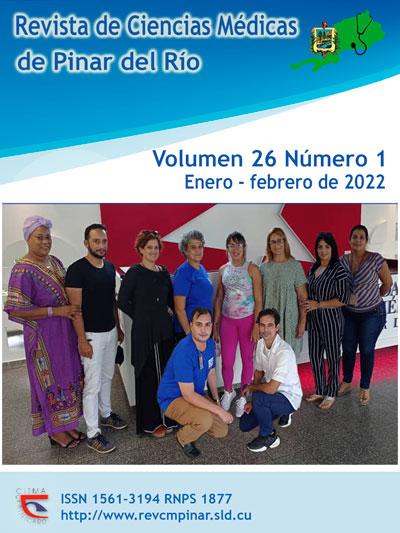Elements of a teaching method considering the diversity of students addressed to the teaching staff of dentistry major
Keywords:
CULTURAL DIVERSITY, STUDENTS, EDUCATION, MEDICAL, ODONTOLOGIA.Abstract
Introduction: a professor who attends to the individual and diverse characteristics of students can contribute to the quality of the teaching-learning process.
Objective: to draw up a teaching method responding to the diversity of students addressed to the teaching staff of dentistry major.
Methods: a descriptive and qualitative research was carried out in Dentistry major at Las Tunas University of Medical Sciences, during the academic course 2019-2020. The field of research was defined considering the diversity of Dentistry students and as an object in the postgraduate teaching-learning process. The research was carried out in four stages: 1) analysis of the program-D of study and guiding documents; 2) review of articles, theses and other documents; 3) drawing up the teaching method and 4) introduction of the teaching method to be enriched by the criteria of professors.
Results: a teaching method was drawn up and presented considering the diversity of Dentistry students and intended for the professors of this major. The teaching method was structured with a general objective, six specific topics, each with objectives, content system (knowledge, development of skills and values) along with teaching tasks. Different knowledge systems on pedagogical and didactic aspects, curricular design, comprehensive pedagogical diagnosis, historical study and theoretical foundations, related to student diversity were addressed.
Conclusions: a teaching method was drawn up for the postgraduate course addressed to the teaching staff of dentistry major.
Downloads
References
1. PCC. VIII Congreso del Partido Comunista de Cuba; La Habana[Internet]. 2018 [Citado: 15/04/2021]. 2021. Disponible en: https://www.parlamentocubano.gob.cu/index.php/informe-central-al-8vo-congreso-del-partido-comunista-de-cuba-pdf/
2. Huguet Blanco Y, Quintana Gómez F, Franco Pérez P, Sosa Fleites I. Preparación de profesores en ciencias médicas: una visión desde las páginas de EDUMECENTRO. EDUMECENTRO [Internet]. 2018 [Citado: 15/04/2021]; 10(3): [aprox. 19 p.]. Disponible en: http://www.revedumecentro.sld.cu/index.php/edumc/article/view/1154
3. Santos Velázquez T, Panizo Bruzón SE. Resultados obtenidos en el examen estatal por estudiantes de Estomatología en los que se atendió su diversidad. Rev. electrón. "Dr. Zoilo E. Marinello Vidaurreta[Internet]. 2020 [Citado: 15/04/2021]; 45(1): [aprox. 9 p.]. Disponible en: http://revzoilomarinello.sld.cu/index.php/zmv/article/view/1962/pdf_648
4. Reglamento para el Trabajo Docente y Metodológico de la Educación Superior. Resolución No. 2/2018. Gaceta Oficial de la República de Cuba, No.25[Internet]. 2018 [Citado: 15/04/2021]. Disponible en: https://instituciones.sld.cu/faenflidiadoce/files/2018/08/Resoluci%c3%b3n-2-del-2018.pdf
5. Hernández Millán AB, Mora Pérez C. Tareas docentes sobre contenidos de Estomatología Legal en la especialidad Estomatología General Integral. EDUMECENTRO[Internet]. 2016 [Citado: 15/05/2021]; 8(1): [aprox. 13 p.]. Disponible en: http://www.revedumecentro.sld.cu/index.php/edumc/article/view/546
6. Reyes González JI. Didáctica de la Historia Social Integral. Curso Pre-evento Academia y Sociedad, Universidad de Las Tunas, Las Tunas, Cuba. 2018
7. Suárez Denis AL, Núñez Martínez MC, Llano Arana L, Sánchez Ortiz L, Rodríguez Lorenzo Md, Morejón Barrueto Y. Efectividad de la aplicación de un diplomado para atender la diversidad estudiantil en ciencias médicas. EDUMECENTRO[Internet]. 2017[Citado: 15/04/2021]; 9(1): [aprox. 21 p.]. Disponible en: http://www.revedumecentro.sld.cu/index.php/edumc/article/view/798
8. Arteaga Pupo F. La filosofía de la educación desde la obra martiana. Las Tunas: Editorial Académica Universitaria[Internet]. 2016 [Citado: 15/04/2021]. Disponible en: http://edacunob.ult.edu.cu/bitstream/123456789/12/1/La%20filosof%c3%ada%20de%20la%20educaci%c3%b3n%20desde%20la%20obra%20martiana.pdf
9. Santos Velázquez T, Panizo Bruzón SE. Acciones educativas para atender la diversidad estudiantil en Estomatología en el contexto de la COVID-19. Rev. electrón. "Dr. Zoilo E. Marinello Vidaurreta"[Internet]. 2020 [Citado: 15/04/2021]; 45(4): [aprox. 7 p.]. Disponible en: http://revzoilomarinello.sld.cu/index.php/zmv/article/view/2334/pdf_692
10. Carnero Sánchez M, González Domínguez NY. El diagnóstico integral en la Educación Superior. Una concepción dinámica, cooperativa e interventiva. Atenas[Internet].2020 [Citado: 15/10/2021]; 4(52): [aprox. 16 p.]. Disponible en: http://atenas.umcc.cu/index.php/atenas/article/view/598/885
11. Izaguirre Remón R, Algas Hechavarría L, Nuevo Pí M, Alejandrez Tamayo R. Algunos fundamentos teóricos para las investigaciones pedagógicas en la educación médica superior. MULTIMED[Internet]. 2017 [Citado: 15/04/2021]; 21(2): [aprox. 9 p.]. Disponible en: http://www.revmultimed.sld.cu/index.php/mtm/article/view/498
12. Santos Velázquez T, Reyes González JI, Sánchez Rojas M. Estudio histórico de la atención a la diversidad de estudiantes de Estomatología en el proceso enseñanza aprendizaje. Rev. electrón. "Dr. Zoilo E. Marinello Vidaurreta[Internet]. 2020 [Citado: 15/05/2021]; 45(2): [aprox. 8 p.]. Disponible en: http://revzoilomarinello.sld.cu/index.php/zmv/article/view/2105
13. MINSAP. Adecuaciones del Curso Escolar en Ciencias Médicas ante el impacto de la COVID19. La Habana: MINSAP[Internet]. 2020 [Citado: 15/04/2021]. Disponible en: https://salud.msp.gob.cu/adecuaciones-del-curso-escolar-en-ciencias-medicas-ante-el-impacto-de-la-covid-19/
14. MES. Gaceta Oficial de la República de Cuba. No. 65/2019: Resolución No. 140/2019. Ministerio de Educación Superior. Reglamento de la Educación de posgrado de la República de Cuba[Internet]. 2019[Citado: 15/04/2021]. Disponible en: http://legislacion.sld.cu/index.php?P=FullRecord&ID=357
Downloads
Published
How to Cite
Issue
Section
License
Authors who have publications with this journal agree to the following terms: Authors will retain their copyrights and grant the journal the right of first publication of their work, which will be publication of their work, which will be simultaneously subject to the Creative Commons Attribution License (CC-BY-NC 4.0) that allows third parties to share the work as long as its author and first publication in this journal are indicated.
Authors may adopt other non-exclusive license agreements for distribution of the published version of the work (e.g.: deposit it in an institutional telematic archive or publish it in a volume). Likewise, and according to the recommendations of the Medical Sciences Editorial (ECIMED), authors must declare in each article their contribution according to the CRediT taxonomy (contributor roles). This taxonomy includes 14 roles, which can be used to represent the tasks typically performed by contributors in scientific academic production. It should be consulted in monograph) whenever initial publication in this journal is indicated. Authors are allowed and encouraged to disseminate their work through the Internet (e.g., in institutional telematic archives or on their web page) before and during the submission process, which may produce interesting exchanges and increase citations of the published work. (See The effect of open access). https://casrai.org/credit/



